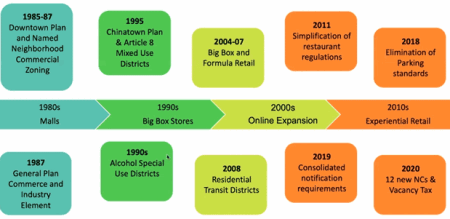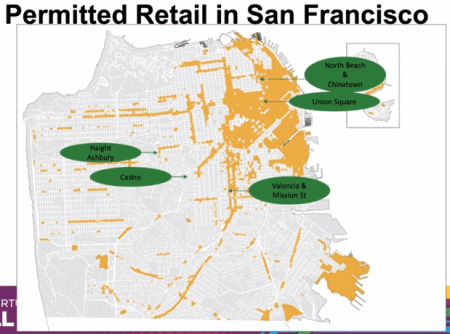The COVID-19 lockdown imposed by San Francisco in late February devastated the city’s small, independent businesses, and especially its restaurant scene, panelists said at the ULI Virtual Fall Meeting session titled “Vibrant Retail Streets in the Age of E-tail and COVID-19: Is It Time for ‘Retail First’ City Policies?” But they proposed creative policies that could help nimble retailers survive.
“The lockdown was a challenge for many businesses,” noted Yanni Taylor, president of Field Paoli Architects and moderator of the panel. “If you look at the size of San Francisco relative to other cities such as Los Angeles, New York, Chicago, or Dallas, you will find that the city has suffered a disproportionate number of closures, whether permanent or temporary.”
The COVID-19 emergency orders hit the restaurant industry particularly hard, said Laurie Thomas, executive director of the Golden Gate Restaurant Association, a local advocacy group. “There are 4,000 smaller, independent restaurants in San Francisco. When the city issued the emergency declaration, within 48 hours we saw massive cancellations to the city’s convention business.” This created a domino effect for other local businesses, she said. “The James Beard Foundation and Compass Lexecon reports are anticipating an 85 percent permanent closure rate for small, independent restaurants. The longer it takes for us to reopen, the higher that rate will be.”
One thing that could help struggling small businesses would be an update to the city’s code, said Sheila Nickolopoulos, senior planner with the San Francisco Planning Department. “We knew prior to COVID-19 that it was time to assess policies,” she said.
The Commerce and Industry Element of the city’s General Plan was last updated in 1987, and the world has changed a lot since then, she noted. “The core values of economic vitality, social equity, and environmental quality remain true today, but the specific guidance in there is antiquated. Our policy is really focused on supporting and preserving our unique neighborhoods.”
The COVID-19 landscape has altered the tenant/landlord relationship somewhat, said Laura Sagues Barr, senior vice president of commercial real estate services firm CBRE. “Retail as a product type has been facing serious headwinds for a while, certainly pre-COVID, and is positioned in some ways to be a bit more nimble,” she said. “In many cases, yes, it is a tenant’s market, but oddly enough, that’s not the case completely across the board. There’s a big difference between retail zones that were strong pre-COVID versus neighborhoods and areas that may have had other reasons they were struggling.”
During the pandemic, COVID has forced both tenants and landlords to come up with creative solutions to create new businesses or to modify existing ones.
“COVID is definitely impacting deal structure,” Barr said. “The three most common buckets are straight percentage deals, and the other two are either a percentage structure for a set period of time—in many cases 18 to 24 months with a set base rent that increases from there—or there’s an option to structure the deal of a rent reset based on sales, but that’s often a landlord-only option. The spirit of that [is] to offer some upside for a landlord that’s taking more of a risk.” Traditional deals continue to be executed, she said, though she cautioned those currently are not the norm.
The panelists agreed that the pandemic has reshaped the retail sector to an unprecedented degree, largely by necessity. “Our city did a really smart thing and brought a lot of the business, faith, nonprofit, and labor leaders together on an economic recovery task force,” Thomas said. The emergency declaration gave the city extraordinary powers to streamline implementation of several measures that would have taken months normally, such as governing outdoor seating, she noted. “I think this was the right thing to do to streamline things for the greater good.”
“One of the takeaways from the task force was to remove barriers and make it easier for businesses to survive,” said Nickolopoulos. The city needs to be able to allow businesses to have multiple types of trade within their space, such as a café that sells clothing or a retail spot with a coffee bar, she said.
“Flexibility is key,” Barr agreed. “Retail is innovating faster than physical space. We’re going to see more need for takeout windows; curbside pickup is going to be huge. There’s always a constant [misperception] that the internet is killing retail, but brick and mortar is not going anywhere. There’s obviously a lot that needs to happen to keep some of our most important institutions alive and happy. I’m really hopeful that some of what needs to happen there happens.”
The retail sector will survive and adapt, the panelists noted. “It’s not all been bad news. IKEA is planning on opening a store in downtown San Francisco,” Taylor said. “It’s nice to know that some retailers are able to look beyond the current crisis, and I think that is very positive news.”
“I’m optimistic about the resilience of cities,” Nickolopoulos said. “Cities have been around since humans started gathering together, and I think that there’s a particular magic you find in neighborhoods and city streets that you will never get in online shopping.”
“I’ve certainly heard and read that the pandemic has reminded us of some of the small pleasures in life that we’ve taken for granted—going for a walk in a lively neighborhood commercial district or eating out with friends, browsing in the local store,” concluded Taylor. “And, so I would like to encourage our audience to patronize your local retailers and restaurants—appropriately and with health and safety in mind, of course.”
JUSTIN ARNOLD is a senior manager for communications at ULI.





